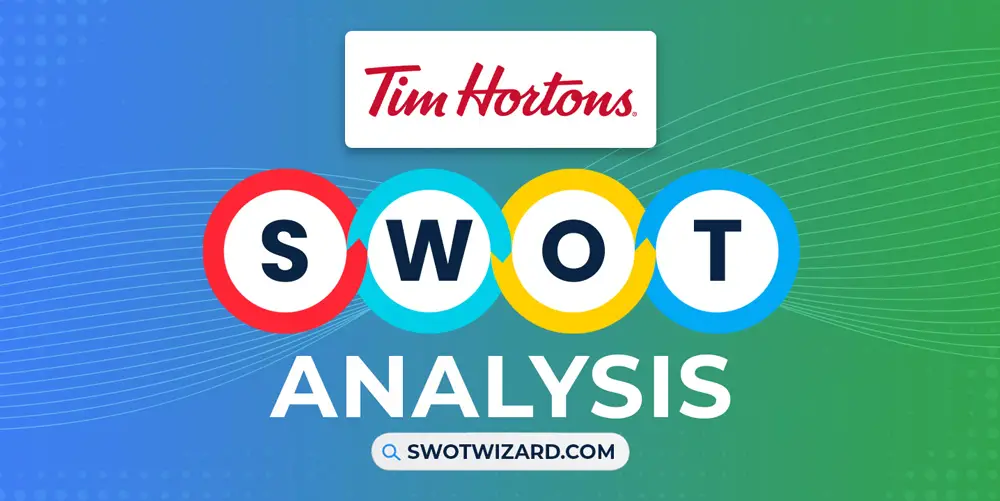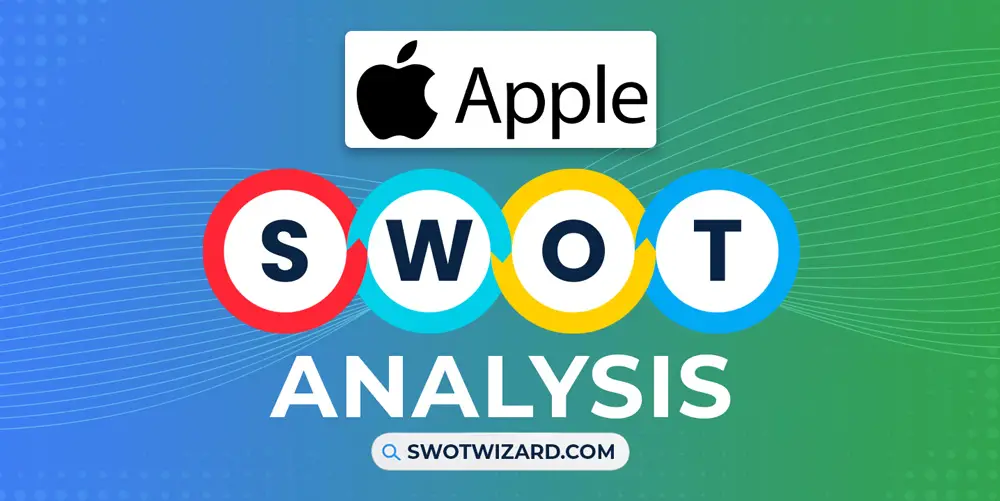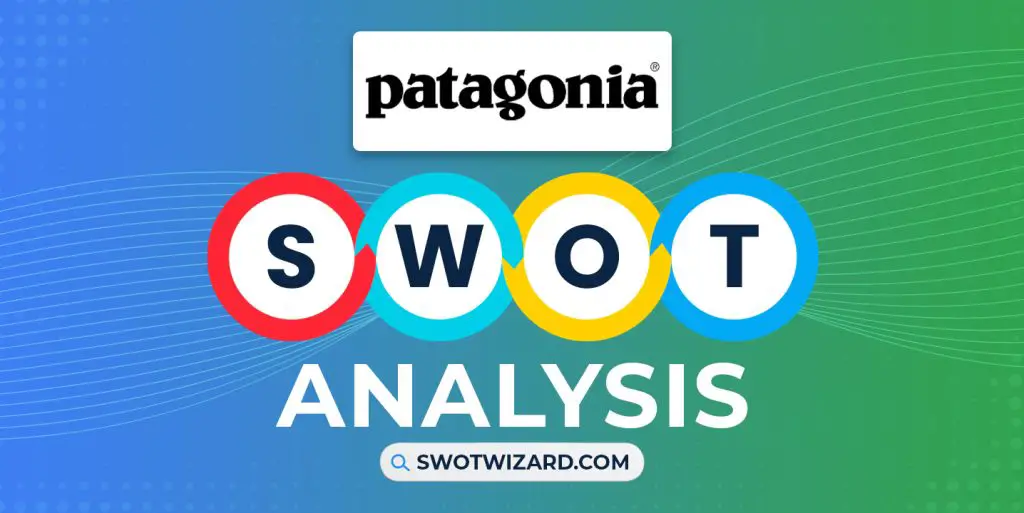Tim Hortons was a Canadian ice hockey player’s attempt at launching a business, which has evolved into one of the iconic symbols of Canada over time. Now, Tim Hortons is a fast-food and coffee chain giant with over 5,352 shops internationally. To understand its success story, let’s explore the Tim Hortons SWOT analysis.
Tim Hortons: Company Overview
| Company | Tim Hortons Inc. |
| Industry | Restaurants |
| Founded | 17 May, 1964 |
| Founder | Tim Horton, Jim Charade |
| President | Axel Schwan |
| Headquarter | Toronto, Ontario, Canada |
| No. of Employees | 20,000+ |
| Annual Revenue | $3.34 billion (FY 2021) |
| Website | timhortons.com |
In 1964, Canadian ice hockey player Tim Horton opened a donut shop called Tim Horton Donuts with Jim Charade. The shop was located in Hamilton, Ontario, Canada, and sold coffee for only 10 cents per cup. Tim Hortons created its iconic Timbits in 1976 and slowly introduced other baked goods after 1981. By 2008, the average Tim Hortons franchisee was generating 265,000 USD as net earnings.
By 2022, Tim Hortons had made 1,945 million USD in systemwide sales and generated a 3.34 billion USD revenue in 2021. The brand is currently a multinational coffeehouse and restaurant chain giant that operates from Toronto in Ontario, Canada.
Product & Services of Tim Hortons
Timbits | Donuts | Muffins | Cookies | Pastries | Bagels | Sandwiches & Wraps | Oatmeal | Hashbrowns | Coffee | Iced Coffees | Ice Caps | Ice Latters | Ice Smoothies | Ice Lemonade
Tim Hortons Competitors
Starbucks | McDonald’s | Dunkin Donuts | Burger King | Chick-fil-A | Subway | Panera Bread Co | Bojangles’ Inc
Did You Know?
In 1975, founder Horton’s wife Lori sold her 49.5% share to partner Ron Joyce for 1 million CAD and a Cadillac. In 1987, Lori Horton sued Joyce claiming she was mentally incapable at the time. The lawsuit fell through, but she attempted a second suit in 1995.
Strengths – Tim Hortons SWOT Analysis
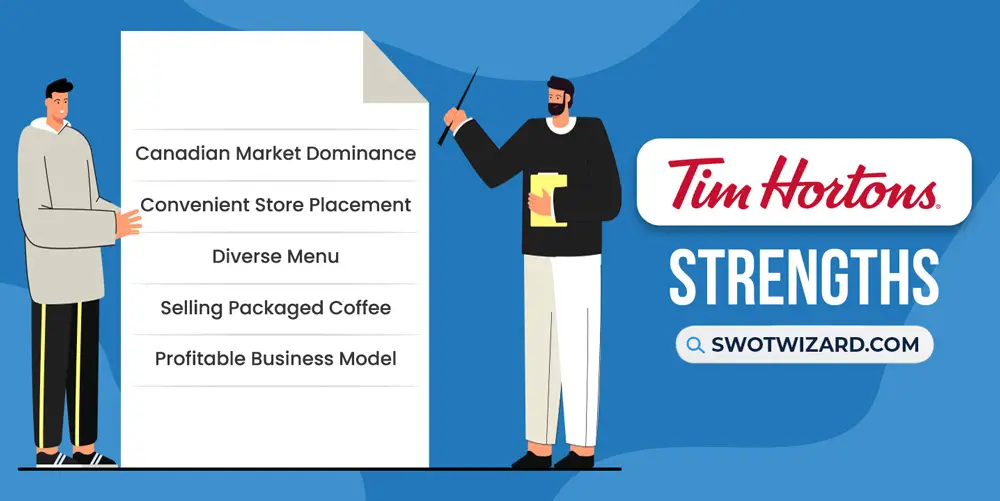
Canadian Market Dominance: Tim Hortons had over 4200 shops in Canada by May 2022 while Starbucks only had 900. In 2023, Tim Hortons has over 3569 locations in Canada, which makes it the largest food chain in the country. By 2023, international competitors like Subway opened 2,921 locations, Starbucks opened 1,405, McDonald’s 1,367, KFC 644, Dominos 591, and Pizza Hut opened 556 locations in Canada. Spread over 628 cities, Tim Hortons continues to dominate the Canadian market unchallenged.
Convenient Store Placement: Tim Hortons’ stores are always placed with easy access and visibility in mind. For example, store number 234693 is located at 915 Bloor St West in Oshawa, Ontario. Some other stores are located at 320 Capital Drive in Charlottetown, 1680 Water Street in Miramichi, 2680 Simcoe Street North in Oshawa, and 637 Kingston Road in Toronto. These stores are either placed at locations with high visibility with no competitors nearby or have easy access across busy streets, drawing in more customers.
Diverse Menu: Tim Hortons offers a diverse menu that includes breakfast, lunch, baked goods, hot and iced coffee, and other beverages. The brand offers around 8 breakfast items, 8 lunch items, 15 donuts and Timbits, and 7 types of baked goods. It also offers 9 kinds of hot beverages and 7 kinds of cold ones. Having a menu with so many options allows the brand to appeal to larger demographics and always have new options for consumers to explore.
Selling Packaged Coffee: In the US, Tim Hortons offers its ground and whole bean premium blends, finely ground and whole bean original roast, ground dark roast, French vanilla, and decaffeinated blends in 12-ounce packs. It also offers single-serve coffee variations of all these flavors in 12 and 24-count packs. In Canada, the brand also sells chamomile and lemon tea pouches. By offering its beverages in packaged format, it can access tea and coffee drinkers who like Tim Hortons’ flavor profile but also like to enjoy beverages in the comfort of their homes.
Profitable Business Model: 99.9% of Tim Hortons locations are franchised, and the business model is profitable for both the brand and the franchisees. Including the initial franchise fee, real estate taxes, personal property taxes, site planning and development cost, building cost, training, professional and license fees, and more, the total estimated cost of opening a franchise comes to 1,044,000 to 1,441,500 USD. With 4.5 to 6% of gross sales as royalty and another 4% spent on marketing, a franchisee can make more than 100,000 as a profit. For the brand, it provides training and licensing in exchange for a large upfront fee and a revenue stream.
Weaknesses – Tim Hortons SWOT Analysis
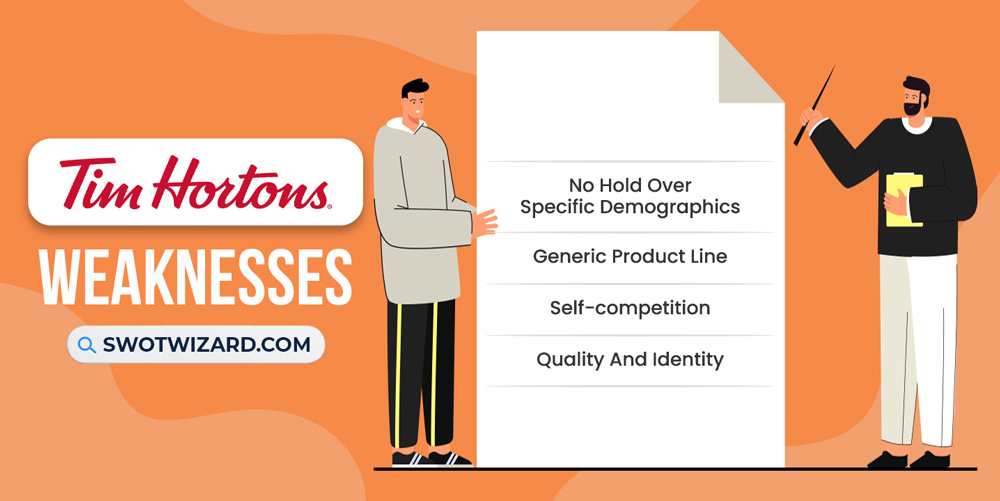
No Hold Over Specific Demographics: While Tim Hortons is often considered synonymous with Canada, it doesn’t specialize in targeting demographics beyond that image. Tim Hortons’ target demographics want North American foods, fast and casual service, a broad menu with options, or food within a budget. Unfortunately, competitors like McDonald’s, Subway, and Starbucks all satisfy the needs of these demographics. Some consumers are loyal to Tim Hortons, but they make up a small portion of the 2 billion coffees the brand sells each year.
Generic Product Line: Tim Hortons’ key product is coffee, which is a generic product with little room for innovation and improvement and has an oversaturated market. Without producing newer flavors, or visually appealing drinks, the brand cannot stand out. Unfortunately, Tim Hortons’ business model relies on selling high volumes at affordable prices. So, producing and selling extravagant drinks to consumers might be detrimental to its revenue.
Self-competition: By 2022, 48% of Tim Hortons restaurants were in Ontario, Canada. By placing so many outlets close to each other, the brand is causing a proximity-based self-competition. Being careless about franchise placement has led to Tim Hortons cannibalizing its sales, as every outlet is getting fewer consumers than it should. By not expanding into more markets, the brand is jeopardizing its growth and revenue.
Quality And Identity: A survey conducted in 2018 revealed 19% of consumers thought Tim Hortons’ coffee quality had worsened, while 13% of Starbucks consumers reported an improvement. 25% of consumers reported a decline in Tim Hortons’ service quality while 13% reported an improvement in Starbuck service quality. Consumers also felt confused by the brand’s 60 experimental menu item launches in 2019, as these did not go with the brand identity at all. The loss in quality and identity is attributed to the 2014 3G Capital takeover, which is known for its aggressive cost-cutting measures and efficient operations.
Opportunities – Tim Hortons SWOT Analysis

Expanding Into New Zealand Markets: Tim Hortons can enter the New Zealand coffee market, which is highly resistant to adverse changes and has higher average coffee consumption per capita than both Australia and the UK. In 2020, the country’s coffee market saw a revenue shrinkage of only 15.8% and bounced back to making over 1.06 billion USD by 2023. The market is also expected to grow by 5.14% by 2025 per year, making it the ideal investment.
Expanding Beyond Coffee: Tim Hortons already has a diverse menu collection, but none of the items can replace coffee. Unfortunately, Tim Hortons has had to deal with lower sales numbers for its hot drinks and coffee since the pandemic. On the other hand, cold beverages have seen increased sales numbers, showing greater interest from consumers. So, Tim Hortons can use this opportunity to push their cold beverages more and expand their range, creating unique drinks that give the brand an edge.
Ghost Labeling: Tim Hortons can get rid of their less popular coffee or tea products through ghost labeling. By selling as a ghost label, the brand doesn’t have to bear marketing costs and experiment with new blends.
Threats – Tim Hortons SWOT Analysis

Stiff Competition: Tim Hortons is facing powerful competitors such as Dunkin’, Starbucks, McDonald’s, and Subway. Starbucks has already overtaken it in product quality and service scores, and McDonald’s and Dunkin’ aren’t far behind. Over time, Tim Hortons can fall miles behind its competition.
Industry Oversaturation: New businesses are always forming in the fast-food and coffee industry and competing with hype marketing or lowballing tactics. Even if these businesses die out, the frequency of invasions can easily chip away at a significant portion of Tim Hortons’ consumer base.
Health Consciousness: Consumers have become more health conscious after the pandemic, showing reluctance to indulge in food considered problematic. Most of Tim Hortons’ menu items fall under this category, and this could cause the brand to lose a lot of consumers.
[Bonus Infographic] SWOT Analysis of Tim Hortons
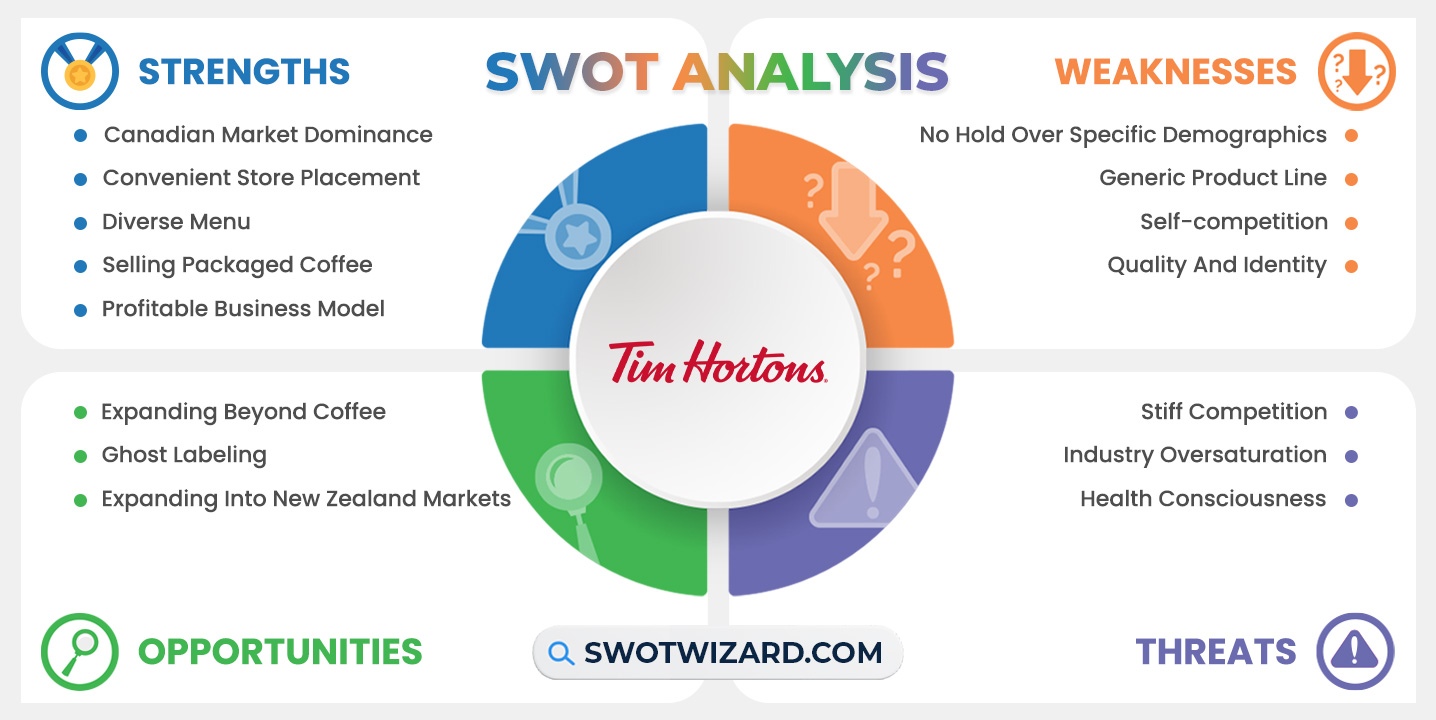
Recommendations for Tim Hortons
To sustain its business, Tim Hortons can consider these options.
- The brand can expand into Australia, where it can exploit its 10.9 billion USD coffee industry.
- Instead of randomly adding menu items, it can release special items celebrating special days and movements. If these items gain popularity, then they can be added to the menu.
- Tim Hortons can donate a percentage of each sale to charity, generating increased sales from public interest in donations.
- Tim Hortons can send in anonymous reviewers, and conduct unannounced inspections to ensure that its product and service quality meets expectations.
Frequently Asked Questions (FAQs)
How many coffees does Tim Hortons serve per day?
Tim Hortons serves up to 5 million coffees per day.
What was Tim Hortons’ 1st slogan?
Tim Hortons’ 1st slogan was “Your friend along the way”.
Final Words on Tim Hortons SWOT Analysis
Tim Hortons has been the quintessential coffee chain for Canada for decades. However, relying on past glory and aggressive cost-cutting has led to the brand losing out to its competition. For Tim Hortons to survive, it has to improve its food and service quality and expand into new markets.
References
- Wikipedia contributors. (n.d.). Tim Hortons Inc. Wikipedia.
- Tim Hortons Target Market: Who Enjoys Tim’s? And Why? (2022, September 16). AMPLIFY XL.
- Tim Hortons Competitors. (n.d.). Comparably.
- FDD Talk: Tim Hortons Franchise Costs, Fees, Average Revenues and/or Profits (2022 Review). (2022, June 19). Franchise Chatter.
- Hunter, D. (2017, February 21). Tim Hortons. The Canadian Encyclopedia.
- McKinnon, T. (2020, February 21). Tim Hortons is Struggling to Win Over Customers, Here’s Why. Indigo9 Digital.
- Moretti, J. (2022, May 15). The 8 Largest Coffee Chains In Canada (With Numbers). BaristaJoy.
- Marsh, C. (2018, January 30). How did Tim Hortons come to be synonymous with Canada; and why do we continue to embrace that identity? National Post.
- Pandurov, M. (2022, November 17). 20+ Delicious Tim Hortons Facts [Collected in 2022]. Reviewlution.
- Quick, T. (2021, April 22). The rise of the health-conscious consumer. LinkedIn.
- Restaurant Brands International Inc. Reports Third Quarter 2022 Results. (2022, March 11). Restaurant Brands International.
- Roughan, G. (2020, October 29). The Key Coffee Industry Trends For 2023 & Beyond. Unleashed Software.
- 10 Largest food chains in Canada in 2023. (n.d.). ScrapeHero.
- Simmons, T. (2022, June 7). How much do Tim Hortons Owners earn annually? Discovery Finance.
- Coffee – New Zealand. (n.d.). Statista.
- Fresh Facts | Corporate. (n.d.). Tim Hortons.
- Menu. (n.d.). Tim Hortons.
- Tim Hortons Franchising. (n.d.). Tim Hortons.
- History. (n.d.). Tim Hortons.

